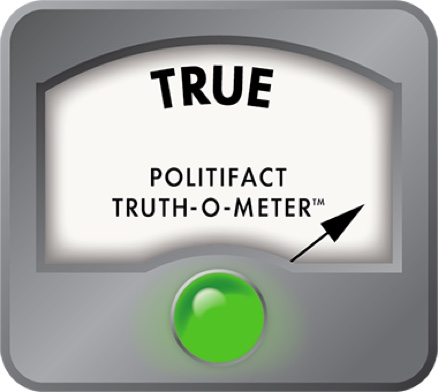
“Nearly 25 cents of every $1 spent via SNAP goes to farmers and ranchers,” Hong wrote.
Though the law has since been passed, we thought this claim was still worth a look. How much money are farmers getting as a result of SNAP?
Let’s take a look.
USDA: In 2023, about 25 cents of every food-at-home dollar went to farmers
Asked to back up her claim, Hong’s office provided a chart published earlier this year by the U.S. Department of Agriculture’s Economic Research Service. The chart shows that in 2023, farm establishments made 24.3 cents for every dollar spent on food at home, including at grocery stores and supermarkets.
A quick reminder: SNAP dollars are restricted to food only and, for the most part, can’t be spent at restaurants. That makes the food-at-home dollar the focus here.
Back to the 24.3 cents — it’s an average of all people and all food purchased for at-home consumption, said Paul Mitchell, director of the Renk Agribusiness Institute at UW-Madison. In other words, it’s not specific to SNAP recipients.
But research shows SNAP and non-SNAP households have similar purchasing habits for food they eat at home. So, assuming SNAP recipients are average consumers, Hong’s claim is accurate, Mitchell said.
There is some nuance here, because the farmer’s share differs by type of food. In general, the less processed the food is and the fewer hands that are involved in getting it to the consumer, the more the farmer receives, Mitchell said.
For example, according to data from the Economic Research Service compiled by the National Farmers Union, a farmer would receive 50 cents on the dollar for apples and more than 60 cents on the dollar for eggs. That drops to one cent on the dollar for a wheat bagel and less than that for corn cereal.
But again, the Economic Research Service’s statistic that farms made 24.3 cents for every dollar spent on food at home is an average of all types of food.
Dawn Thilmany, a professor of agriculture and resource economics at Colorado State University, said Hong’s claim is accurate and may even be a slightly conservative estimate when accounting for SNAP dollars spent at farmers’ markets or food retailers that source locally.
Thilmany also pointed to Double Up programs, meant to incentivize healthy eating by matching SNAP recipients’ dollars on fruits and vegetables at certain farmers markets. For example, Dane County’s Double Dollars program matches SNAP dollars up to $20 at area farmers markets, and vendors are fully reimbursed.
That makes the money more likely to go back to where farmers farm, Thilmany said. She called it a win for health and for the economy.
Our ruling
Hong claimed that nearly 25 cents of every dollar spent via SNAP goes to farmers and ranchers.
Recent data from the USDA’s Economic Research Service backs that up, and experts confirmed its accuracy.
We rate this claim True.
